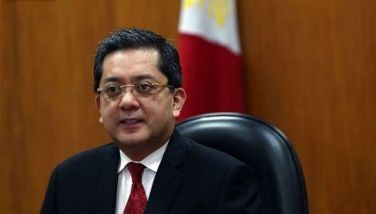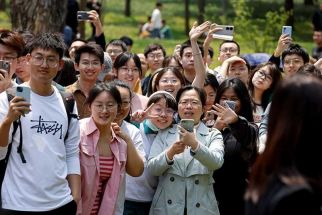PCIJ audit: Senate candidates on social media
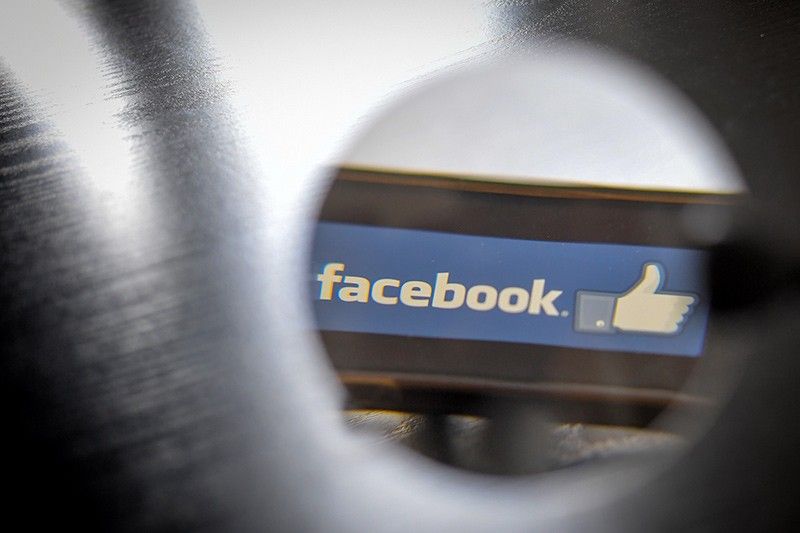
Money and the May 2019 elections
(Philippine Center for Investigative Journalism) — A “promotional touchpoint.” That, in advertising and PR parlance, is what social media apparently looks like to candidates for senator in the May 2019 elections, and they have been using it as such even ahead of the official 90-day campaign period, which started last Tuesday.
Because the use — and even abuse — of social media is practically free and unbridled, PCIJ launched this audit of how and what the candidates are posting, how often and where, and how much organic or boosted engagement they are drawing.
Are their posts backed by heavily paid media push? Who has invested in small or big ways in social-media management? Who commands small or big social-media machinery, or enjoy affinity with Filipinos online?
This audit covers 20 candidates for senator listed in Pulse Asia’s latest nationwide survey on the May 2019 Senatorial Elections that was conducted from Dec. 14 to 21, 2018 using face-to-face interviews. These candidates are also among those most actively engaged in social media.
This audit offers information reflected from scans and observations based on the curated social-media posts of the candidates throughout the month of January.
READ: P2.4-B pre-campaign ads: Bong Go, Marcos, Roxas, Roque top spenders
It presents at best some discernible trends but does not assume or conclude that certain candidates have “paid” supporters or trolls, have resorted to boosting their posts, or are using advertising monies unless stated otherwise with supporting data and documents.
The key figures presented, notably, fan or follower base and number of posts and engagement, are the data gathered when this report was written on Feb. 8, 2019. There could be discrepancies in the key figures after this date because the fan or follower base and additional new posts of the candidates may have already either increased or decreased during the intervening days.
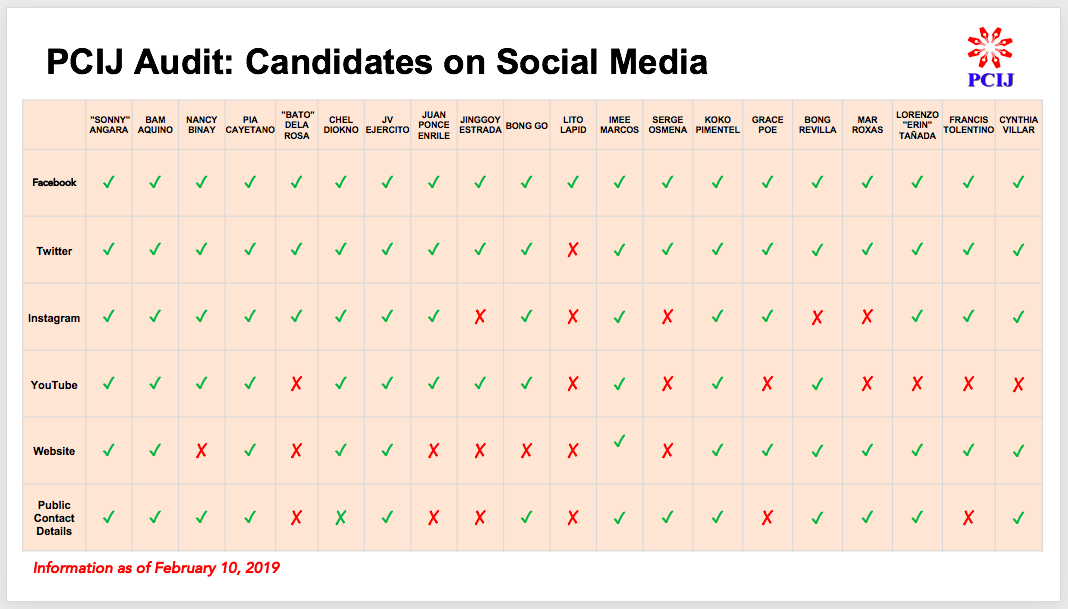
This report has two sections.
The first is a social media landscape overview. It looks at which candidates are on which social media platform, and what they are doing there. This focuses on a rundown of the social-media assets where the 20 candidates for senator are active, with topline observation on their overall use of social media.
READ: Candidates, beware: Law bans bribery, cash gifts, donations
The second is a content scan of the Facebook pages of 13 candidates with more frequent activities on Facebook. It looks at who is saying what on Facebook, and how a candidate is saying it.
This section offers information on the total posts, total engagement, average engagement per post and numbers of likes, comments, and shares reflected on the candidates’ Facebook pages.
Candidates on social media
Their social media and communication strategies vary but all the 20 candidates covered in this audit are consistent about one thing: they have all turned to Facebook as their go-to social media platform of choice, apparently to reach the greatest number of Filipinos online.
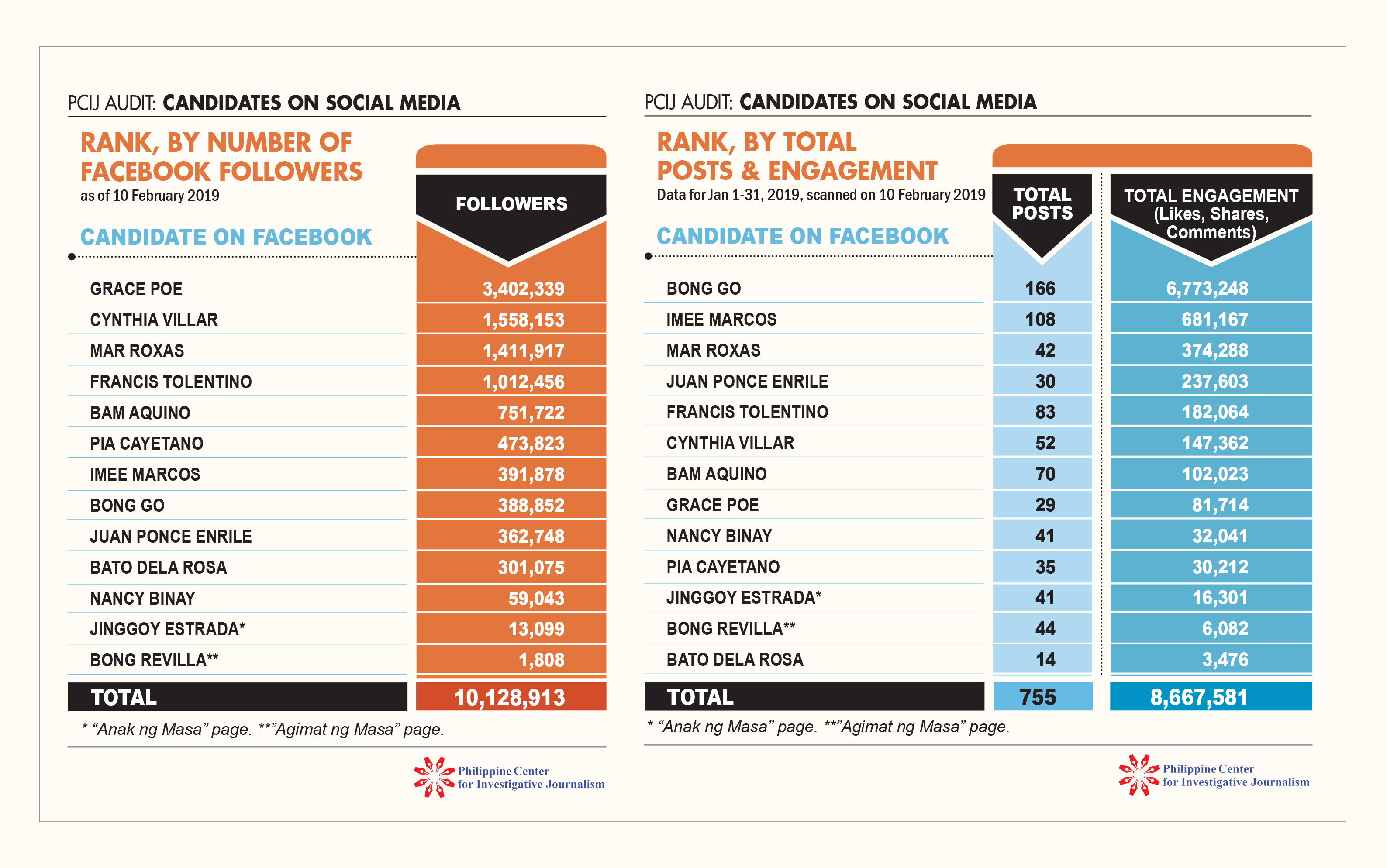
The data gathered for this audit offer more insights:
- Majority of the candidates who use Twitter include those currently in office, running for re-election, or recently resigned from executive positions. They are regularly tweeting about their work at the Senate, posting photos of their events and links to press releases, or retweeting news articles associated with their efforts. These candidates have been posting more “editorial-type” content that departs from the more personal and lifestyle-slanted use of Facebook by its native followers.
- Certain social-media pages have apparently been created solely for the purpose of the upcoming midterm elections. These include the recently created “Anak ng Masa” page of Jose “Jinggoy” Estrada and the “Agimat ng Masa” page of Ramon “Bong” Revilla Jr. Both candidates have had existing social-media accounts prior to January 2019. Juan Ponce Enrile, meanwhile, has been active on Facebook way before, but Twitter and Instagram accounts have been set up for him recently, as additional channels.
- Instagram and YouTube appear to be less popular channels for the candidates’ promotional efforts on social media. Some candidates are more active than others in terms of updating their accounts on Instagram and YouTube. These are not as heavily and as regularly used as the candidates’ Facebook and Twitter accounts.
- The websites or microsites of many candidates appear to be static and are not being updated regularly. The only exceptions are the websites of Ma. Imelda “Imee” Marcos and Paolo Benigno “Bam” Aquino IV that feature regular content uploads of press releases and other engagement materials. The other websites contain key information about the candidate only, i.e., Jose Manuel “Chel” Diokno, Lorenzo “Erin” Tanada III, and Pia Cayetano. The website of Manuel “Mar” Roxas II features materials from the 2016 elections yet and is not loading properly. Bong Revilla’s website is password-protected while Grace Poe’s is still under construction (as of Feb. 12, 2019).
- A majority of the candidates have provided public contact details that allow interested audiences to use to get in touch with them or their team or staff.
FB content scan
In January 2019, the frequency of posting on Facebook among the 13 candidates scanned varied from as few as 14 to as many as over 150 posts, with corresponding post engagement (likes, comments, shares) ranging from a little over 3,000 to an unusually high 6.7 million in total.
Quantity does not automatically translate to quality, however. Some candidates have achieved a much higher engagement on fewer posts than others who have published more posts but have drawn relatively less interaction from the audience.
For example:
- Bong Go published over 160 Facebook posts in January 2019, gaining over 6.7 million likes, comments and shares in total engagement. This number excludes as yet his page’s video views. Dividing 6.7-million engagement by his 160-plus Facebook posts, Go has achieved an average of 40,800 engagements per post.
- Imee Marcos comes in second in terms of posting frequency on Facebook. In January 2019, she published a total of 108 posts. Her average engagement per post of 6,300, however, is significantly lower than Roxas’s average engagement: his 42 posts last month drew an average of 8,900 engagements per post. Juan Ponce Enrile, meanwhile, published 30 posts that each yielded 7,900 engagements on average.
These contrasting results could be explained in part by certain reasons such as, but not limited to, the following:
- Some candidates have offered content and messaging that possibly encouraged higher affinity and relatability values with the audience; and
- The use of “influencers” and “paid media” support to boost the “reach” and “air time” of the candidates’ Facebook posts and/or pages via the audience’s newsfeed.
Video, content drivers
Video content appears to gain the most traction compared to other content formats used by the candidates. This is most apparent in the case of some administration candidates (Bong Go and Francis Tolentino).
The main engagement drivers on their Facebook pages are content or posts that include or feature President Rodrigo Duterte.
These particular posts have drawn more engagement on the Facebook pages of Go and Tolentino, in the form of Comments that are a mix of positive and negative sentiments.
While certain social-media pages are perceived to have been created solely for the purpose of the upcoming midterm elections (i.e., Estrada’s “Anak ng Masa, Revilla’s “Agimat ng Masa,” and Enrile’s additional Twitter and Instagram channels), the other candidates (Bam Aquino, Nancy Binay, Marcos, Poe, and Cynthia Villar) have just shifted or added “topics” to the existing content on their social media pages.
These additional content have given these candidates a subtle push for their campaign for the Senate.
Puzzling numbers
Data on the total engagement and average engagement per post of the 13 candidates, referenced against the number of their fans or followers, are rather puzzling.
The data point to possible boosting of the posts of some candidates via clearly aggressive social-media management and marketing strategies.
Those obtained from the Facebook pages of Bong Go and Imee Marcos show them to be outliers, in terms of unusually high total engagement numbers their posts got, compared with the rest of the 13 candidates included in this Facebook content scan.
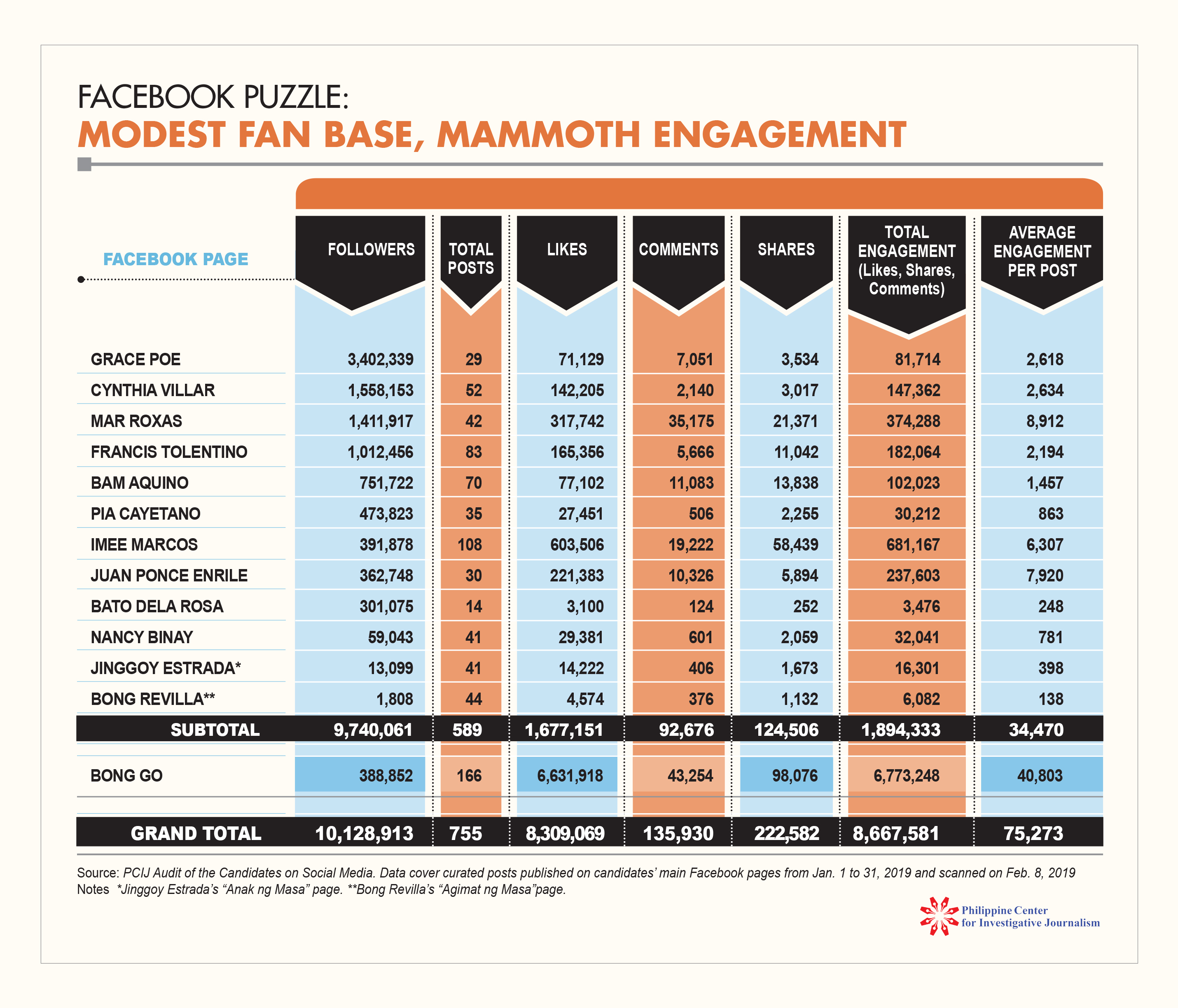
For instance, by the number of organic followers or fan base reflected on their Facebook pages, as of last Feb. 8, here’s how the candidates rank:
- Grace Poe, 3,402,339 followers;
- Cynthia Villar, 1,558,153;
- Mar Roxas, 1,411,917;
- Francis Tolentino, 1,012,456;
- Bam Aquino, 751,722;
- Pia Cayetano, 473,823;
- Imee Marcos, 391,878;
- Bong Go, 388,852;
- Juan Ponce Enrile, 362,748;
- Ronald “Bato” dela Rosa, 301,075;
- Nancy Binay, 59,043;
- Jinggoy Estrada, 13,099; and
- Bong Revilla, 1,808.
By the number of posts that they published on their Facebook pages from January 1 to 31, 2019, here’s how they rank:
- Bong Go, 166 posts;
- Imee Marcos, 108;
- Francis Tolentino, 83;
- Bam Aquino, 70;
- Cynthia Villar, 52;
- Bong Revilla, 44;
- Mar Roxas, 42;
- Nancy Binay, 41;
- Jinggoy Estrada, 41;
- Pia Cayetano, 35;
- Juan Ponce Enrile, 30;
- Grace Poe, 29; and
- Bato dela Rosa, 14.
No guarantees
Big fan bases did not automatically deliver big reach numbers for all the candidates.
By the total engagement numbers (sum of likes, comments, shares) they got for the posts they published on their Facebook pages from Jan. 1 to 31, 2019, they ended up in this unusual kind of ranking:
- Bong Go, 6,773,248 total engagement;
- Imee Marcos, 681,167;
- Mar Roxas, 374,288;
- Juan Ponce Enrile, 237,603;
- Francis Tolentino, 182,064;
- Cynthia Villar, 147,362;
- Bam Aquino, 102,023;
- Grace Poe, 81,714;
- Nancy Binay, 32,041;
- Pia Cayetano, 30,212;
- Jinggoy Estrada, 16,301;
- Bong Revilla, 6,082; and
- Bato dela Rosa, 3,476.
Dividing their total engagement numbers by their total posts for the month of January, here’s how the candidates rank, by average engagement per post:
- Bong Go, 40,803 average engagement per post;
- Mar Roxas, 8,912;
- Juan Ponce Enrile, 7,920;
- Imee Marcos, 6,307;
- Cynthia Villar, 2,634;
- Grace Poe, 2,618;
- Francis Tolentino, 2,194;
- Bam Aquino, 1,457;
- Pia Cayetano, 863;
- Nancy Binay, 781;
- Jinggoy Estrada, 398;
- Bato dela Rosa, 248; and
- Bong Revilla, 138.
Incredible few
What the data show are incredibly high total and average engagement numbers for just a few candidates.
For instance, while the 13 candidates obtained combined total engagement of 8,667,581 in all, the 12 candidates (excluding Bong Go) accounted only for 21.8 percent or 1,894,333 combined total engagement in their Facebook pages in January.
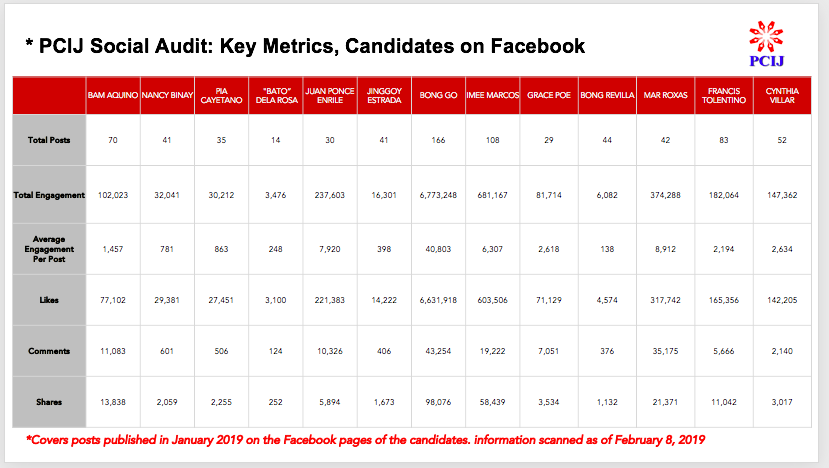
In contrast, Bong Go’s total engagement number of 6,773,248 that same month accounted for 78.1 percent of the grand total engagement for the 13 candidates. In other words, Bong Go’s total engagement number is thrice more than what the 12 other candidates achieved in January 2019.
If the composite total of 1,894,333 for the 12 candidates is further reduced by Imee Marcos’s total engagement of 681,167 (7.8 percent of grand total engagement of the 13 candidates), the new composite total for the remaining 11 candidates would be 1,213,466 only, or just 14 percent of the grand total of 8,667,581 engagement.
Boosting posts
Facebook allows page admin managers to boost posts to reach targeted audiences to grow their organic fan base and reach new audiences, based on specified age, location, sex, or interests. Boosting may be done across duration periods of one day, seven days, or 14 days, by Facebook’s default buttons.
Hootsuite, a social media management system that gives users an integrated user interface from which to manage their social interactions, gives a glimpse of how this is done in the United States.
In its guide to using Facebook’s push button, Hootsuite explains that boosting a post for people living in the United States 18 years old and above may cost from as low as US$1 to US$2 to reach from 163 to 872 people; US$5 (432 to 2,070 people), and US$15 (1,506 to 6,834 people). The fees may vary, depending on the location of the targeted audience, but “technically, you can pay any amount you want.”
According to Hootsuite’s guide, “the minimum budget is $1 per day, so hypothetically, you could run a campaign for a week with just $7. Obviously, the more you pay, the more reach you’re going to get.”
Quick read
- Post: A material published on someone’s Facebook page, whether in the form of a static post, GIF/slideshow, video, long-form note or text status.
- Engagement: The response a post receives from the audience, including likes/reactions, comments and shares or retweets.
- Total engagement: The sum of all the likes/reactions, comments and shares or retweets a post receives.
- Average engagement per post: The average number of engagement a particular set of posts receives. (Total engagement divided by Total posts = Average engagement per post)
- Reach and Impressions: Metrics that can be seen only by FB page admins via FB Insights/Ads Manager. “Reach” pertains to the actual number of people who have seen a post, while “Impression” pertains to the number of times it was seen or served to the people reached, i.e. if a post is seen twice by each of the 10 people reached, then the total impressions of the said post would be 20.
- “Boosting”: The use of paid advertising monies to push for higher reach/impressions, engagement, and/or views for a particular post or content. “Boosting” of a Facebook page can also be done to increase its number of fans/followers.
— With reporting by Malou Mangahas and infographics by Arnel Rival, PCIJ, February 2019
- Latest
- Trending

























